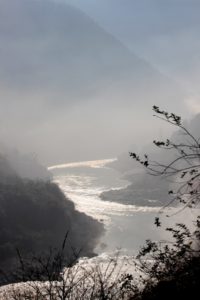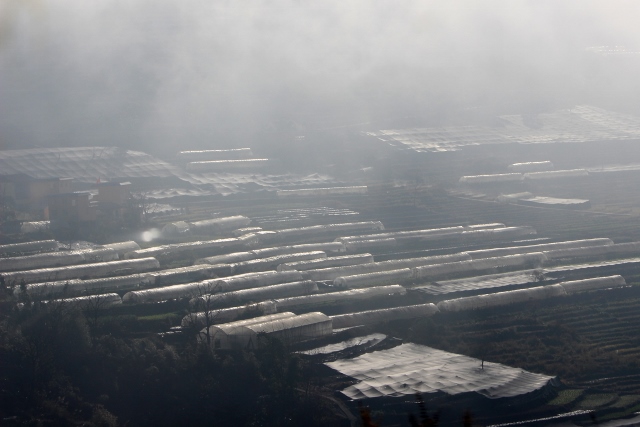The Nujiang Valley, the valley of the Nu River, proves that remote does not necessarily means undeveloped.
In every reference, guide book or internet site, the Nujiang Valley is described as one of the remotest parts of Yunnan. Significantly, in none of our 20-year old tourist guides the place was even mentioned (perhaps it was in any case off-limits for tourists at the time). Spectacular scenery is provided by the steep mountain slopes that encroach on the fast-flowing river. All along, minority villages are clinging to the valley wall, often impossibly high up the slopes. All this creates, at least for me, expectations of an authentic, back-to-the-last-century experience, little wooden houses, colourfully dressed people. Picturesque. So we were going to travel all the way to Bingzhongluo, at the very end of the valley – or the beginning, whichever way you look at it, in any case the furthest access point by road -, not to miss any of this.
Hmmm. The reality was a little different, and a little disappointing perhaps. The Nujiang Valley may be remote, on account of the effort it takes to get there, but as in so many other places in China, it is pretty densely populated for what arable land there is. And arable land is a very broad concept here, the slopes of the mountains are, where possible, terraced, to quite high up. The Chinese version of glass-houses, plastic-covered metal frames, are many, and otherwise vegetable plots are protected with large black sheets. The development I have been talking about has also penetrated into the valley. Everywhere are modern houses, the square two- or three storey concrete constructions, on flat land along the river, but also up the slopes, where they are supported by concrete pillars. Entire complexes with hundreds of new houses, once again many unfished, dominate the lower ranges of the scenery. Nothing like picturesque villages, here.
And those colourful minorities, they occur mostly on murals, or as happily dancing troupes in promotional videos of the tourist board. Occasionally some of the women in the villages we pass wear their traditional head scarf; very rarely they go around in traditional dresses. They do exist, those dresses, as a market reveals, where several stalls are dedicated to minority clothing – the romantic concept I held that these are patiently handmade during long nights by the minority women themselves has been well and truly shattered, these are all machine-made.
Perhaps in the ‘ethnic villages’, of which several are signposted along the road, by the same tourist board, the traditional clothing is more frequently worn, but here, too, their authenticity may be compromised.
Anyhow, next more about the actual trip.
























Ook hier slaat de moderne tijd toe!!